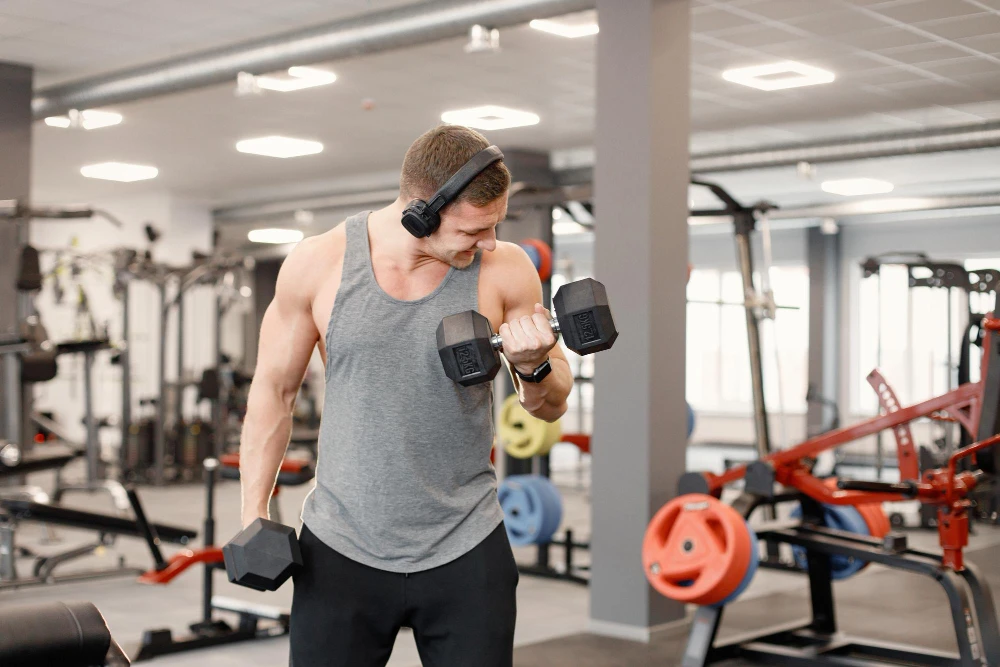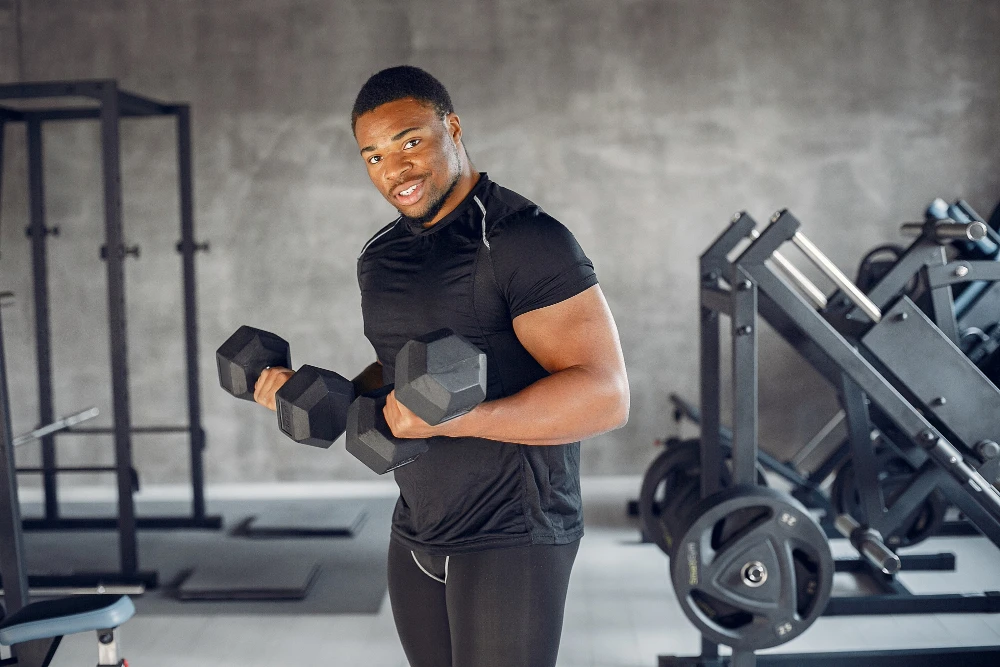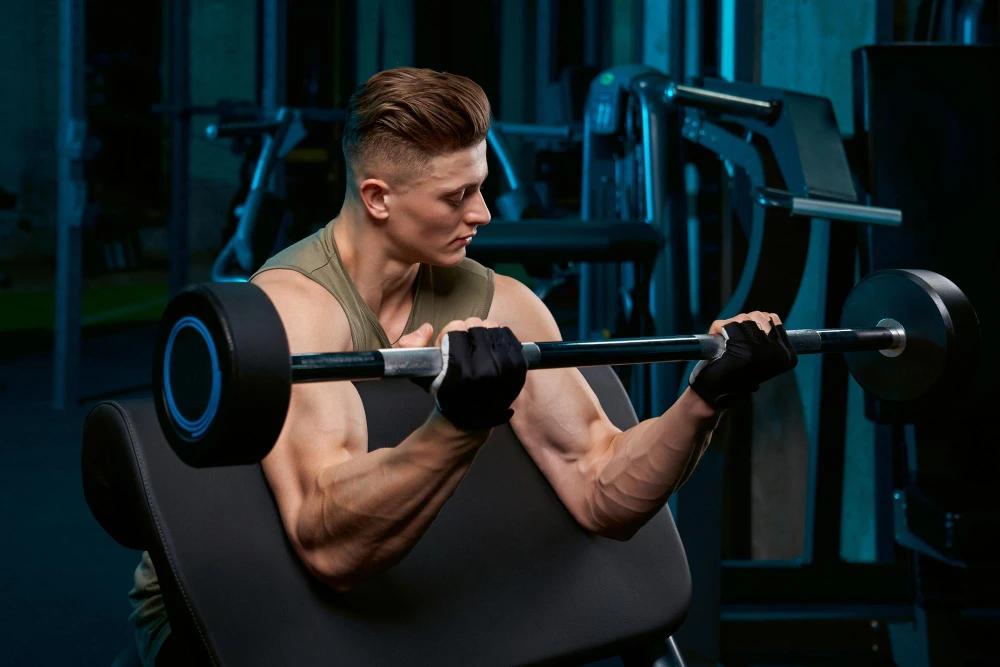Have you ever wondered why bicep curls exercises are such a popular exercise for building muscle mass? The answer lies in the science behind how they stimulate muscle growth.
Bicep curls target the bicep brachii muscle, which is responsible for flexing the elbow and rotating the forearm. When you perform bicep curls, you create tension in the muscle fibers, which causes small micro-tears. These tears are then repaired by the body, resulting in muscle growth and increased strength. But that’s not all – the type of bicep curl you do can also impact the muscle fibers that are targeted, leading to even more gains.
Whether you’re a seasoned weightlifter or just starting out, understanding the science behind bicep curls can help you optimize your workouts and achieve your fitness goals.
So, let’s dive deeper into the fascinating world of bicep curls and muscle growth!
How Bicep Curls Stimulate Muscle Growth?
Bicep curls are a popular exercise for building muscle mass in the bicep muscle. When you perform bicep curls, you create tension in the muscle fibers, which causes small micro-tears. These tears are then repaired by the body, resulting in muscle growth and increased strength. This process is known as muscle hypertrophy.
Muscle hypertrophy can be divided into two types – myofibrillar hypertrophy and sarcoplasmic hypertrophy. Myofibrillar hypertrophy involves an increase in the size and number of myofibrils, which are the contractile units within muscle fibers. This type of hypertrophy is associated with increased strength and power. Sarcoplasmic hypertrophy, on the other hand, involves an increase in the volume of the sarcoplasm, which is the fluid within muscle fibers. This type of hypertrophy is associated with increased muscle size and endurance.
Bicep curls primarily stimulate myofibrillar hypertrophy, which means that they are effective at increasing strength and power in the bicep muscle. However, the type of bicep curl you do can also impact the muscle fibers that are targeted, leading to even more gains.

The Science Behind Muscle Hypertrophy
Muscle hypertrophy is a complex physiological process that involves the activation of satellite cells, which are located on the surface of muscle fibers. These satellite cells are responsible for repairing and regenerating muscle tissue after exercise-induced damage.
When you perform bicep curls, you create tension in the muscle fibers, which activates the satellite cells. The satellite cells then fuse with the existing muscle fibers, increasing their size and number. This process is known as muscle hypertrophy.
Muscle hypertrophy can be influenced by a variety of factors, including exercise intensity, volume, and frequency. In general, higher intensity and volume of training are associated with greater muscle hypertrophy. However, it’s important to note that individual variability plays a significant role in muscle hypertrophy, and what works for one person may not work for another.
Types of Bicep Curls and Their Effectiveness
There are many different types of bicep curls, each of which targets the bicep muscle in slightly different ways. Some of the most popular types of bicep curls include:
- Standing Bicep Curls
Standing bicep curls are performed while standing with a dumbbell in each hand. The palms of the hands should be facing forward, and the weights should be lifted towards the shoulders. This exercise primarily targets the bicep brachii muscle.
- Hammer Curls
Hammer curls are performed with a dumbbell in each hand, with the palms facing each other. The weights are lifted towards the shoulders, targeting both the bicep brachii muscle and the brachioradialis muscle, which is located in the forearm.
- Concentration Curls
Concentration curls are performed while seated, with one arm resting on the inner thigh. The weight is lifted towards the shoulder, targeting the bicep brachii muscle. This exercise is often used to isolate the bicep muscle and improve its size and definition.
- Preacher Curls
Preacher curls are performed using a preacher bench, which supports the arms and isolates the bicep muscle. The weight is lifted towards the shoulders, targeting the bicep brachii muscle. This exercise is often used to improve the size and definition of the bicep muscle.
Each type of bicep curl has its own unique benefits and can be used to target specific areas of the bicep muscle. By incorporating a variety of bicep curls into your workout routine, you can maximize muscle growth and improve overall strength and power.
Common Mistakes to Avoid When Performing Bicep Curls
Here are some common mistakes to avoid when performing bicep curls:
- Using too much weight. This is one of the most common mistakes people make when doing bicep curls. If you use too much weight, you’ll be more likely to use momentum to lift the weight, which will take the stress off of your biceps and put it on other muscles, such as your shoulders and forearms.
- Not using a full range of motion. Another common mistake is not using a full range of motion. When you curl the weight up, make sure to fully extend your elbow at the bottom of the movement. This will help to ensure that you’re working your biceps through their full range of motion.
- Swinging the weight. Another common mistake is swinging the weight up and down. This is a sign that you’re using too much weight or that you’re not using proper form. Make sure to keep your elbows in place and focus on using your biceps to curl the weight up.
- Not engaging the biceps. One of the most important things to do when doing bicep curls is to make sure that you’re engaging your biceps. This means that you should feel your biceps contracting as you curl the weight up. If you’re not feeling your biceps contract, you’re probably not using proper form or you’re using too much weight.
How to Incorporate Bicep Curls into Your Workout Routine?
Bicep curls can be incorporated into your workout routine in a variety of ways. One common approach is to include bicep curls as part of your upper body workout, either at the beginning or end of the workout. You can also incorporate bicep curls into your full body workout, either as a standalone exercise or as part of a superset with another exercise.
It’s important to vary the type, intensity, and volume of bicep curls you perform to maximize muscle growth and prevent plateaus. You can also increase the challenge of the exercise by incorporating drop sets, super sets, or other advanced training techniques.

The Importance of Progressive Overload in Bicep Curl Training
Progressive overload is the process of gradually increasing the amount of weight you lift or the number of repetitions you perform over time. This is the key to building muscle and strength, and it’s just as important for bicep curls as it is for any other exercise.
When you first start doing bicep curls, you may be able to curl a relatively light weight for a high number of repetitions. However, as you get stronger, you’ll need to increase the weight or reduce the number of repetitions in order to continue challenging your muscles. This will help them grow and get stronger.
There are a few different ways to implement progressive overload in your bicep curl training. One way is to simply increase the weight you’re lifting each time you do curls. Another way is to reduce the number of repetitions you perform each time you increase the weight. You can also combine these two methods.
For example, you might start by curling 10 pounds for 15 repetitions. Once you can do that easily, you could increase the weight to 12 pounds and reduce the number of repetitions to 12. As you get stronger, you could continue to increase the weight and reduce the number of repetitions.
It’s important to note that progressive overload should be done gradually. If you try to increase the weight too much too quickly, you’re more likely to get injured. Start with small increases and gradually work your way up to heavier weights.
Progressive overload is a simple but effective way to build muscle and strength. If you want to get bigger and stronger biceps, make sure to incorporate progressive overload into your training.
Here are some additional tips for using progressive overload in your bicep curl training:
- Focus on compound exercises. Compound exercises work multiple muscle groups at the same time, which is more efficient for building muscle and strength. Bicep curls are a compound exercise, but you can also get a good workout for your biceps by doing compound exercises like pull-ups, chin-ups, and rows.
- Train regularly. You need to train consistently in order to see results. Aim to train your biceps at least twice per week.
- Get enough rest. Your muscles need time to recover after you train them. Make sure to get at least 7-8 hours of sleep each night.
- Eat a healthy diet. A healthy diet provides your body with the nutrients it needs to build muscle and strength. Make sure to eat plenty of protein, complex carbohydrates, and healthy fats.
By following these tips, you can use progressive overload to build bigger and stronger biceps.
Nutrition Tips for Maximizing Bicep Muscle Growth
Here are some nutrition tips to help you maximize your bicep muscle growth:
- Consume enough calories to support growth. If you’re not eating enough calories, your body won’t have the energy to build muscle. Aim to eat 200-300 calories more than your maintenance calories each day.
- Get in plenty of protein. Protein is essential for muscle growth and repair. Aim to eat 1.2-1.6 grams of protein per kilogram of body weight each day.
- Keep your carbohydrate intake moderate. Carbohydrates provide your body with energy, but too many carbohydrates can lead to fat gain. Aim to get 45-65% of your calories from carbohydrates.
- Don’t fear dietary fats. Healthy fats are essential for hormone production and cell growth. Aim to get 20-35% of your calories from healthy fats.
- Get your fill of fluids. Staying hydrated is important for muscle growth and recovery. Aim to drink 1-2 gallons of water each day.
In addition to following these general nutrition tips, you can also incorporate specific foods into your diet that are known to help with muscle growth. Some of these foods include:
- Eggs are a great source of protein and other nutrients that are essential for muscle growth.
- Lean meats such as chicken, fish, and beef are also good sources of protein.
- Tofu and other plant-based proteins are also a good option for vegetarians and vegans.
- Dairy products such as milk, yogurt, and cheese are a good source of protein and calcium.
- Whole grains such as brown rice, quinoa, and oats are a good source of carbohydrates and fiber.
- Fruits and vegetables are a good source of vitamins, minerals, and antioxidants.
By following these nutrition tips, you can maximize your bicep muscle growth and achieve the results you want.
Let’s Sum Up
Bicep curls are a highly effective exercise for building muscle mass in the bicep muscle. By understanding the science behind how bicep curls stimulate muscle growth, you can optimize your workouts and achieve your fitness goals. Remember to vary the type, intensity, and volume of bicep curls you perform, incorporate progressive overload, and consume a diet that is rich in protein and complex carbohydrates.
With these tips, you can maximize bicep muscle growth and improve overall strength and power.



